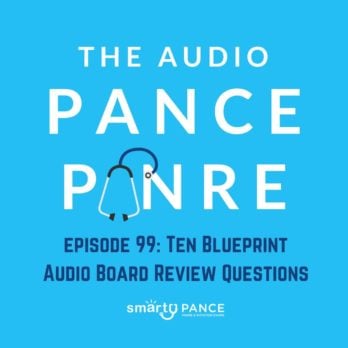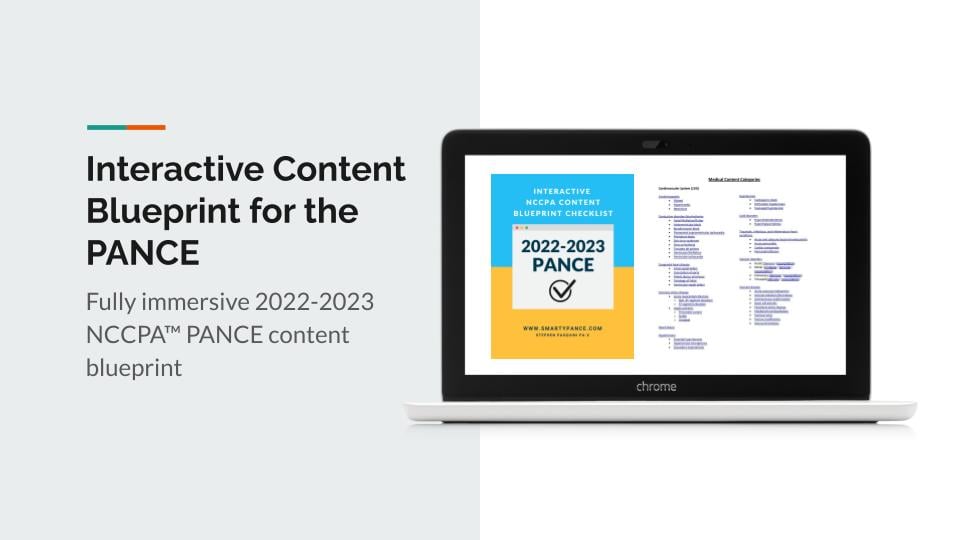Podcast: Play in new window | Download
Subscribe: Apple Podcasts | RSS
 Welcome to episode 99 of the Audio PANCE and PANRE Physician Assistant/Associate Board Review Podcast.
Welcome to episode 99 of the Audio PANCE and PANRE Physician Assistant/Associate Board Review Podcast.
Join me as I cover ten PANCE, PANRE, and EOR™ review questions from the Smarty PANCE Instagram/Facebook page and the smartypance.com board review website.
Special from today’s episode:
- Join the Smarty PANCE Member’s Community
- Check out our all-new End of Curriculum™ (EOC) Exam Course (still in development)
- Follow Smarty PANCE and The Daily PANCE Blueprint on Instagram
- Follow Smarty PANCE and The Daily PANCE Blueprint on Facebook
Below you will find an interactive exam to complement today’s podcast.
The Audio PANCE/PANRE and EOR PA Board Review Podcast
I hope you enjoy this free audio component to the examination portion of this site. The full board review course includes over 2,000 interactive board review questions and is available to all members of Smarty PANCE.
- You can download and listen to past FREE episodes here, on iTunes, Spotify, Google Podcasts, Stitcher, and most podcasting apps.
- You can listen to the latest episode, take an interactive quiz, and download more resources below.
Listen Carefully Then Take the Practice Exam
If you can’t see the audio player, click here to listen to the full episode.
Podcast Episode 99: Ten PANCE/PANRE and EOR Topic Blueprint Questions
1. A 42-year-old male on lithium presents with polyuria, nocturia, and polydipsia. Laboratory findings are remarkable for slightly elevated sodium. Which of the following is the most likely diagnosis?
A. Neurogenic diabetes insipidus
B. Nephrogenic diabetes insipidus
C. Type 2 diabetes mellitus
D. SIADH
E. Adrenal insufficiency
2. A 50-year-old female presents with poor appetite, low energy, poor concentration, and feelings of hopelessness on most days for the past 3 years. She denies suicidal ideation. She has never had a past manic or hypomanic episode. Which of the following is the best treatment option?
A. Haloperidol
B. Fluoxetine
C. Lorazepam
D. Amitriptyline
E. Risperidone
3. An 85-year-old male with a history of chronic kidney disease presents to the ER with muscle cramps. Laboratory studies reveal potassium of 7.8 mEq/L. EKG reveals peaked T waves. Which of the following is the best initial med to give?
A. Insulin
B. Albuterol
C. Furosemide
D. Sodium bicarbonate
E. Calcium gluconate
4. A 28-year-old male with sickle cell disease presents to the ER with chest pain, dyspnea, and a cough for the past day. Vitals are remarkable for SpO2 91% and T 102.2F. A CXR reveals bilateral pulmonary infiltrates. On physical exam the patient is alert, speaking in full sentences, and breathing without accessory muscle use. Which of the following is the most appropriate management option for this patient?
A. Surgical consultation, antibiotics, plasmapheresis, IVIG
B. Pain control, hydration, blood transfusions, oxygen, antibiotics, VTE prophylaxis
C. Immediate endotracheal intubation, aggressive intravenous fluids, antibiotics, blood transfusions
D. Blood transfusions and oxygen only
E. Empiric antibiotics and oxygen only
5. Which of the following is the most common cause of bacterial sialadenitis?
A. Bacteroides
B. Staphylococcus aureus
C. Streptococcus pneumoniae
D. Escherichia coli
E. Streptococcus viridans
6. A 52-year-old female presents to the clinic complaining of chronic bone pain, constipation, and fatigue. Her last lab results reveal a decline in the glomerular filtration rate. Which of the following is the most likely diagnosis?
A. Acute myelogenous leukemia
B. Bronchogenic carcinoma
C. Multiple myeloma
D. Polymyalgia rheumatica
E. Colorectal cancer
7. A 56-year-old post-menopausal G0P0 female presents to the clinic complaining of abnormal uterine bleeding and weight loss for the past 5 months. Physical exam is unremarkable. Which of the following is not a risk factor for this patient’s likely diagnosis?
A. Nulliparity
B. Tamoxifen
C. Chronic anovulation
D. Obesity
E. Late menarche
8. Which of the following are the two most common etiologies of peptic ulcer disease?
A. H. pylori and NSAIDs
B. Spicy foods and acute stress
C. Chemical ingestion and GERD
D. Smoking and alcohol use
E. Chronic stress and radiation
9. A 72-year-old male smoker with a history of cancer presents to the clinic for an annual physical. Vitals are unremarkable. On physical exam, you notice erythema along the course of a superficial vein on his left leg. The area is mildly tender to palpation. The left leg is also larger than the other leg. Which of the following is the next best step?
A. Treat with NSAIDs and warm compresses
B. Order a duplex ultrasound
C. Initial anticoagulation immediately
D. Admit to the hospital
E. Reassurance and send home
10. A 63-year-old male with a history of hepatitis C presents with a pruritic rash located on the flexor surfaces of his wrist. On physical exam, you observe purplish papules with flat-tops. Which of the following is the most likely diagnosis?
A. Atopic dermatitis
B. Psoriasis
C. Lichen planus
D. Pemphigus vulgaris
E. Scabies
Looking for all the podcast episodes?
This FREE podcast series is limited to every other episode, you can download and enjoy the complete audio series by becoming a Smarty PANCE member.
I will be releasing new episodes every few weeks. Smarty PANCE is now discounted, so sign up now before it’s too late!
Additional resources and links from the show
- Download your Free interactive PANCE, PANRE, and EOR™ Blueprint Templates
- Follow Smarty PANCE and The Daily PANCE Blueprint on Instagram
- Follow Smarty PANCE and The Daily PANCE Blueprint on Facebook
- My list of recommended PANCE and PANRE review books
- Sign up for the FREE Daily PANCE and PANRE email series
- Join the Smarty PANCE NCCPA Content Blueprint Website
- Get your free 8-week PANRE Blueprint study schedule and the 8-week PANCE study schedule
- Get your free Trello PANCE study planner
- Get 20% of any Picmonic membership by using this link
This Podcast is available on iOS and Android
- You can download and listen to past FREE episodes here, on iTunes, Spotify, Google Podcasts, Stitcher, and most podcasting apps.
Download the Interactive Content Blueprint Checklist
Follow this link to download your FREE copy of the PANCE/PANRE/EOR™ Content Blueprint Checklists
Print it up and start crossing out the topics you understand, marking the ones you don’t, and making notes of key terms you should remember. The PDF version is interactive and linked directly to the individual lessons on Smarty PANCE.
Smarty PANCE is not sponsored or endorsed by, or affiliated with, the NCCPA or the Physician Assistant Education Association (PAEA). All trademarks are the property of their respective owners.

